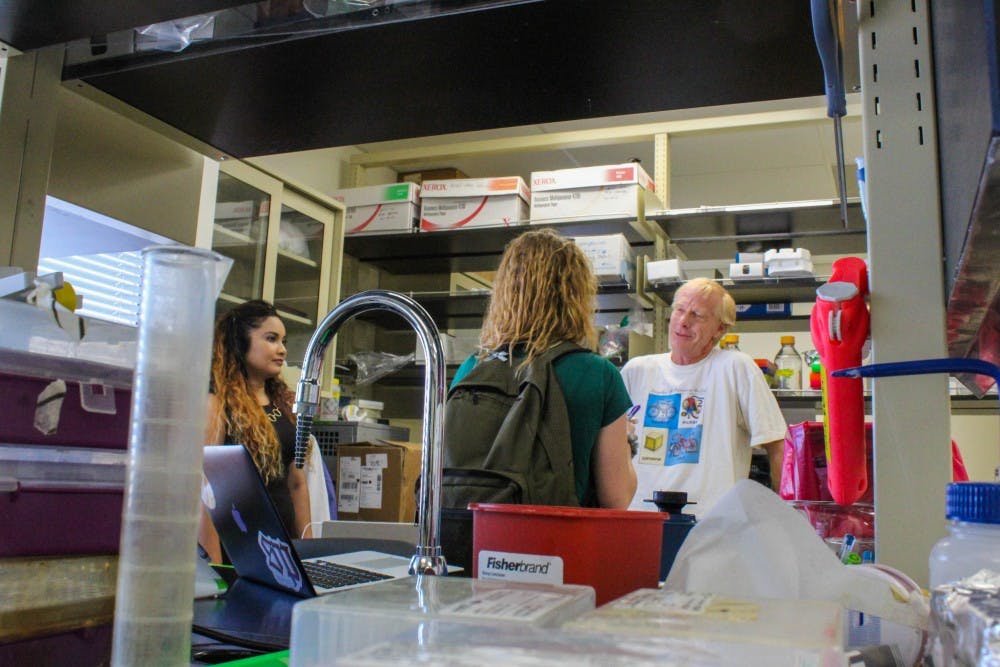ASU researchers have been collaborating with Arizona’s Mayo Clinic to find a way to detect Parkinson's and Alzheimer's before the diseases have affected someone.
Michael Sierks, a researcher and professor at the School for Engineering of Matter, Transport and Energy and Mayo Clinic doctor Charles Adler, have been working on both Alzheimer's and Parkinson's disease to find a way to detect these types of neurodegenerative diseases before it is too late to either stop or reverse them.
“By the time somebody with Parkinson's is diagnosed … somewhere between 50 percent and 90 percent of the dopaminergic neurons are already dead,” Sierks said. “If you can move that diagnosis up to much earlier, to where there is 10 percent to 20 percent dead, then now all you have to do is stop all of the other neurons from dying, but if 80 percent to 90 percent are dead, then you have to work on trying to regenerate the dead ones and relearn all of the movements.”
Stephanie Williams, a postdoctorate research associate has been working with Sierks since the preliminary testing of the Alzheimer's study and will help continue into the next steps of testing for Parkinson's early diagnosis.
“We have been looking at the biomarkers to see if we can generate a profile for early stage and late stage and how early we can pick up those biomarkers," Williams said. "So far we are getting really interesting results in relation to cognition and things like that.”
Parkinson's affects everyone differently over time. However, there are similar side effects of the disease in each patient.
Larry Edmonds, a Parkinson's patient and professor at the College of Integrative Sciences and Arts, was diagnosed with the disease three and a half years ago. Parkinson's disease has already greatly impacted his daily life and his work at ASU.
“I'm at a situation now with the Parkinson's where I teach only online,” Edmonds said. “I am just not able to do the lecture thing and travel back and forth all the time to go to campus … so all my teaching is online now.”
When Edmonds first noticed his Parkinson's symptoms he thought it was just his old age catching up to him, but he said after one too many pens dropped and soups spilled he finally went to see a neurologist. After testing, he was diagnosed with the disease.
Edmonds said his neurologists explained to him that he could expect to experience stiffness in his limbs and difficulty walking as the disease progresses.
There isn't a cure for Parkinson's disease yet, which means that there are not a lot of options for decreasing the symptoms. Edmond said the goal is to prolong the use of your limbs.
“It's mostly just staying on the meds and getting as much movement as you can because once your arms or legs stiffen up in that case, they ain't going to get a whole lot better after that,” Edmonds said.
Sierks, Adler and Williams are all hopeful that they can use the biomarkers to identify the common toxic proteins found in each individual in order to identify early symptoms of the disease.
"With Alzheimer's, we have done a lot of work already showing that we can just analyze blood samples, and we can attack these markers so we can diagnose Alzheimer's disease really early in the process before symptoms have shown up," Sierks said. "(This) is when therapy should be a lot more successful."
Since they have already done the research for the Alzheimer's early diagnosis, the team now hopes to be able to use these makers to discover an early diagnosis for Parkinson's disease.
"The key things we need to develop an early diagnose are patient samples from people before they get the disease because it doesn't do you any good to develop a diagnosis for patents that are already diagnosed," Sierks said.
The team said their next step is getting more funding for the research and patient samples so they can identify Parkinson's disease early, allowing future patients to start therapy earlier to combat the disease.
Reach the reporter at karichm1@asu.edu and follow @Kellyarichmond3 on Twitter.
Like The State Press on Facebook and follow @statepress on Twitter.




